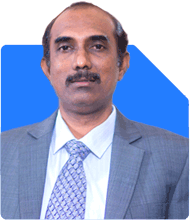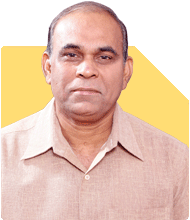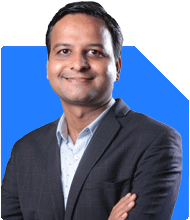Ramalingam Kalirajan |10871 Answers |Ask -Follow
Mutual Funds, Financial Planning Expert - Answered on Jul 12, 2024
He has an MBA in finance from the University of Madras and is a certified financial planner.
He is the director and chief financial planner at Holistic Investment, a Chennai-based firm that offers financial planning and wealth management advice.... more

Mam, I'm 32 year old and aim to build corpse 3 crore in next 25 year. I have NPS of about 1.80 lakh (monthly 4000), PPF 2lakh(2000monthly) 7 lakh of shares and 7 lakhs of mutual fund holding at present. 50k monthly goes to mutual fund which include small cap, flexi cap, bluechip, mid cap,2 global fund and also contributed to 2 insurance for combine 40lakh which will mature in 20 year. 2 lakh in FD, have 30k monthly expense and Have 1.40 lakh monthly income and have 1 kid 1year old.
Current Financial Position
You’re 32 years old and have an impressive portfolio:
NPS: Rs. 1.80 lakh (contributing Rs. 4,000 monthly)
PPF: Rs. 2 lakh (contributing Rs. 2,000 monthly)
Shares: Rs. 7 lakh
Mutual Funds: Rs. 7 lakh (contributing Rs. 50,000 monthly)
Insurance Policies: Sum assured Rs. 40 lakh, maturing in 20 years
Fixed Deposits: Rs. 2 lakh
Monthly Income: Rs. 1.40 lakh
Monthly Expenses: Rs. 30,000
One-year-old child
Mutual Fund Investments
You've diversified across various mutual fund categories: small-cap, flexi-cap, blue-chip, mid-cap, and global funds. This diversification is crucial for balancing risk and return. Let’s analyze the strengths and areas for improvement in your mutual fund strategy.
Advantages of Mutual Funds
Diversification: Mutual funds spread your investment across various sectors and companies, reducing risk.
Professional Management: Fund managers use their expertise to make informed investment decisions.
Liquidity: You can easily buy and sell mutual fund units, providing flexibility.
Compounding: The power of compounding works wonders over long-term investments, especially with regular contributions.
Variety: From equity to debt funds, mutual funds offer a range of options to match your risk tolerance and goals.
Category Analysis
Small-cap Funds: High growth potential but also high risk. Good for long-term growth but monitor performance.
Flexi-cap Funds: Flexibility to invest across market caps. Balanced risk and reward.
Blue-chip Funds: Invest in large, established companies. Stable and reliable returns.
Mid-cap Funds: Middle ground between high-risk small-cap and stable blue-chip funds. Offers growth potential.
Global Funds: Exposure to international markets. Diversifies risk beyond Indian economy.
Evaluating Your Strategy
Risk and Reward Balance
Your mix of small-cap, mid-cap, and blue-chip funds creates a good balance. Small-cap and mid-cap funds offer growth, while blue-chip funds provide stability.
Regular and Long-term Investment
Your Rs. 50,000 monthly SIP in mutual funds is commendable. This disciplined approach leverages the power of rupee cost averaging, reducing the impact of market volatility over time.
Global Exposure
Investing in global funds is wise. It diversifies your portfolio, protecting against domestic market downturns.
Areas of Improvement
Review Fund Performance: Regularly review the performance of your funds. Switch if consistently underperforming.
Avoid Over-diversification: Too many funds can dilute returns. Stick to a well-balanced, manageable number.
Risk Adjustment: As you near your goal, gradually shift from high-risk to low-risk funds to protect your corpus.
National Pension System (NPS)
NPS is a solid long-term retirement tool. Your Rs. 4,000 monthly contribution will benefit from tax advantages and compounding growth.
Advantages of NPS
Tax Benefits: Under Section 80C and 80CCD.
Low Cost: Lower fund management charges compared to mutual funds.
Market-linked Growth: Exposure to equity and debt.
Pension Post-retirement: Provides a steady income stream in retirement.
Public Provident Fund (PPF)
PPF is another excellent tool for long-term savings. It offers tax-free returns and is backed by the government, ensuring safety.
Advantages of PPF
Tax Benefits: Under Section 80C, with tax-free maturity amount.
Guaranteed Returns: Fixed interest rate, reviewed quarterly.
Safe Investment: Backed by the government.
Lock-in Period: 15 years, fostering long-term savings discipline.
Shares and Direct Equity Investments
You have Rs. 7 lakh in shares, providing good growth potential. However, direct equity investments carry higher risks and require active monitoring.
Advantages of Direct Equity
High Returns: Potential for significant capital appreciation.
Ownership: Direct stake in companies.
Dividends: Additional income through dividend payouts.
Risks of Direct Equity
Market Volatility: High exposure to market fluctuations.
Research Intensive: Requires time and expertise to pick and monitor stocks.
Risk of Loss: Potential for significant losses.
Fixed Deposits (FD)
You have Rs. 2 lakh in FDs. While safe, FDs offer lower returns compared to other instruments. They’re suitable for emergency funds or short-term goals.
Advantages of FDs
Safety: Low risk, guaranteed returns.
Liquidity: Easy to withdraw with a penalty.
Fixed Interest: Predictable earnings.
Disadvantages of FDs
Low Returns: Often below inflation, affecting real returns.
Taxable Interest: Interest earned is taxable.
Insurance Policies
Your insurance coverage of Rs. 40 lakh is crucial for financial protection. Ensure it’s adequate based on your financial responsibilities and liabilities.
Benefits of Insurance
Risk Coverage: Financial protection for family.
Tax Benefits: Under Section 80C and 10(10D).
Peace of Mind: Security against unforeseen events.
Review Your Policies
Adequate Cover: Ensure the sum assured meets your family’s needs.
Policy Type: Prefer pure term plans for higher coverage at lower premiums.
Monthly Income and Expenses
Your Rs. 1.40 lakh monthly income with Rs. 30,000 expenses gives a significant surplus for investments.
Savings Rate
High Savings: Allocating a substantial portion towards investments is excellent.
Expense Management: Keep tracking and optimizing expenses.
Investment Recommendations
Increase NPS Contribution: Consider increasing your NPS contribution to maximize tax benefits and retirement corpus.
Continue PPF Contributions: Maintain your PPF contributions for safe, tax-free returns.
Focus on Mutual Funds: Maintain your diversified mutual fund portfolio but review and adjust periodically.
Review Direct Equity: Regularly assess your shares' performance and diversify within sectors.
Maintain Emergency Fund: Keep sufficient funds in FDs or liquid funds for emergencies.
Risk Management and Asset Allocation
Balanced Approach
Equity vs Debt: Maintain a balanced allocation between equity and debt based on your risk tolerance.
Periodic Rebalancing: Adjust your portfolio to stay aligned with your goals and risk appetite.
Education and Future Planning
Your child’s education is a significant future expense. Start an education fund, possibly through child-specific mutual funds or Sukanya Samriddhi Yojana if you have a daughter.
Long-term Planning
Systematic Investment: Start a SIP dedicated to your child’s education fund.
Review Needs: Regularly assess and adjust contributions based on education cost inflation.
Retirement Planning
Your goal of Rs. 3 crore in 25 years aligns with a secure retirement. Continue your disciplined investments and adjust based on life changes.
Post-retirement Income
Diversify Sources: Ensure multiple income streams, including NPS, PPF, and mutual fund returns.
Risk Reduction: Gradually shift to safer investments as you approach retirement.
Final Insights
Your financial journey is commendable. You have a solid base and disciplined approach. Regularly review your portfolio, stay informed, and adjust as needed. Diversification, disciplined investing, and periodic reviews will guide you to your Rs. 3 crore goal.
Best Regards,
K. Ramalingam, MBA, CFP,
Chief Financial Planner,
www.holisticinvestment.in
You may like to see similar questions and answers below
Ramalingam Kalirajan |10871 Answers |Ask -Follow
Mutual Funds, Financial Planning Expert - Answered on May 29, 2024
Ramalingam Kalirajan |10871 Answers |Ask -Follow
Mutual Funds, Financial Planning Expert - Answered on May 27, 2024
Ramalingam Kalirajan |10871 Answers |Ask -Follow
Mutual Funds, Financial Planning Expert - Answered on Jul 19, 2024
Ramalingam Kalirajan |10871 Answers |Ask -Follow
Mutual Funds, Financial Planning Expert - Answered on Jul 01, 2024
Ramalingam Kalirajan |10871 Answers |Ask -Follow
Mutual Funds, Financial Planning Expert - Answered on Jun 02, 2025
Ramalingam Kalirajan |10871 Answers |Ask -Follow
Mutual Funds, Financial Planning Expert - Answered on Dec 06, 2025
Radheshyam Zanwar |6734 Answers |Ask -Follow
MHT-CET, IIT-JEE, NEET-UG Expert - Answered on Dec 06, 2025
Radheshyam Zanwar |6734 Answers |Ask -Follow
MHT-CET, IIT-JEE, NEET-UG Expert - Answered on Dec 06, 2025
Radheshyam Zanwar |6734 Answers |Ask -Follow
MHT-CET, IIT-JEE, NEET-UG Expert - Answered on Dec 06, 2025
Dr Dipankar Dutta |1837 Answers |Ask -Follow
Tech Careers and Skill Development Expert - Answered on Dec 05, 2025
Dr Shyam Jamalabad |108 Answers |Ask -Follow
Dentist - Answered on Dec 05, 2025
Dr Shyam Jamalabad |108 Answers |Ask -Follow
Dentist - Answered on Dec 05, 2025
Dr Shyam Jamalabad |108 Answers |Ask -Follow
Dentist - Answered on Dec 05, 2025
Dr Dipankar Dutta |1837 Answers |Ask -Follow
Tech Careers and Skill Development Expert - Answered on Dec 05, 2025
Ulhas Joshi |280 Answers |Ask -Follow
Mutual Fund Expert - Answered on Dec 05, 2025

























